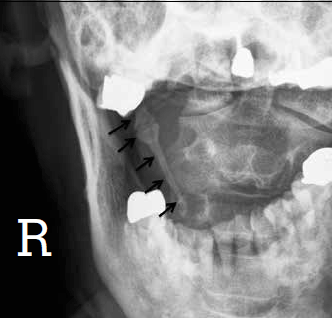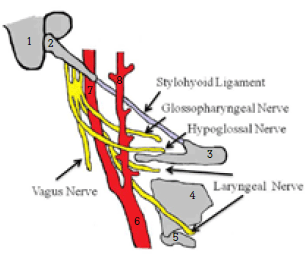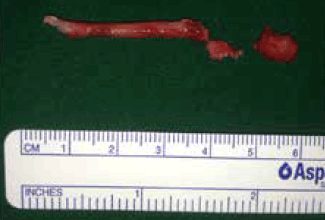
Figure 1. The right styloid process is extremely elongated on reverse Towne’s view (black arrows)
Question 1
What does the X-ray show?
Question 2
What is the diagnosis in this patient?
Question 3
What are the methods used for diagnosis of this condition?
Question 4
What is the aetiology, and what are the main clinical manifestations of this condition?
Question 5
What is the differential diagnosis?
Question 6
What are the treatment options for this condition?
Answer 1
Reverse Towne’s view shows an elongated ossified styloid process on the right side. The length of the right styloid process was >7 cm.
Answer 2
The diagnosis is Eagle’s syndrome, which is a complex condition caused by an elongated styloid process or calcified stylohyoid ligament, which is associated with a wide variety of symptoms, including recurrent episodes of throat pain, pharyngeal foreign body sensation, dysphagia, referred ipisilateral otalgia, neck pain and reduced neck mobility when turning to the affected side, and painful limitation of mandibular opening and lateral excursion.1–3 The normal length of the styloid process in an adult is approximately 2.5 cm.4 By consensus, a styloid process longer than 3.0 cm confers an increased risk of Eagle’s syndrome.5 Although abnormal elongation of the styloid process occurs in approximately 4% of the population, only a small percentage (4–10.3%) is thought to actually be symptomatic.6,7
Answer 3
Diagnosis is made on the basis of clincal symptoms, palpation of the styloid process through the tonsillar fossa, evaluation of pain relief after lidocaine injection, and radiological tests.1,8 The clinician should be suspicious of a history of face and neck pain exacerbated by neck flexion, extension and contralateral rotation. Palpation of the styloid process in the tonsillar fossa with the index finger is indicative of an elongated styloid process and may exacerbate existing symptoms.1 The lidocaine infiltration test can assist in the diagnosis by assessing whether symptoms disappear when the test is performed on the area where the styloid process can be felt in the tonsillar fossa.1 If highly suspicious of Eagle syndrome, confirmation can be made by radiographic studies. Although the styloid process can be observed easily through a lateral-view plain radiograph, the optimal imaging modality for styloid process pathology is spiral computed tomography (CT) of the neck and skull base because CT scans are better for defining length, angulation and anatomical relationships of the stylohyoid process.9 In the present case, reverse Towne’s view showed the elongated styloid process better than the neck CT.
Answer 4
The actual cause of the elongation is a poorly understood process.1 Trauma or surgery (such as tonsillectomy) can lead to ossification or elongation of the stylohyoid complex, which can then impinge on anatomical structures, such as cranial nerves which pass near the styloid process.1,10 Several anomalies of development and bone homeostasis have also been suggested as causes of stylohyoid ossification.1
A diversity of symptoms present according to the length and width of the styloid process, angle and direction of the curve and degree of calcification of the stylohyoid ligament.1 No data could be found to correlate the degree of styloid elongation to symptom severity.11 This condition is characterised by recurrent unilateral pain in the oropharynx, which may radiate to the ear, cheek, jaw, eye or neck. This pain is usually dull, constant and nagging and is often aggravated by swallowing, chewing and yawning.1 Other common symptoms include dysphagia, globus pharyngis, odynophgia or pain with rotation of the head. These symptoms are all caused by stimulation of the V, VII, IX, X and XI cranial nerves near the styloid process.1 As would be predicted by its anatomical course, the glossopharyngeal nerve is most frequently involved (Figure 2).

Figure 2. Schematic diagram of the styloid process and its anatomical correlation with neurovascular structures.
1, mastoid process; 2, styloid process; 3, hyoid bone; 4, thyroid cartilage; 5, cricoid cartilage; 6, common carotid artery; 7, internal carotid artery; 8, external carotid artery
Answer 5
Eagle’s syndrome is distressing to patients and often difficult to diagnose because of the wide variability in symptoms. On the basis of clinical symptoms alone, differential diagnosis can be difficult given the existence of various other diseases with similar presentations (eg. migraine, tension headache, glossopharyngeal neuralgia, atypical facial pain, certain temporomandibular disorders, myofacial pain syndrome, salivary gland disease, tonsillitis, pain of dental origin and phsychosomatic disease).12 These patients may be seen by a surgeon, a dentist, a neurologist and a psychiatrist, often receiving a variety of unnecessary procedures and treatments that do not relieve the symptoms and that cloud the clinical picture.13
Answer 6
Surgical and nonsurgical methods are available for the treatment of Eagle’s syndrome but in most cases, surgery is performed to remove the elongated styloid process via transpharyngeal or external approach.14 Nonsurgical treatments include reassurance, pain control with nonsteroidal anti-inflammatory drugs and transpharyngeal infiltration of steroids or anesthetics in the tonsillar fossa.15
Case continued
Once the diagnosis was confirmed, surgical treatment was undertaken. The surgery was performed through the transpharyngeal approach. The styloid process was exposed and a length of about 50 mm was resected (Figure 3). The patient made an excellent postoperative recovery without postoperative bleeding or other complications, such as deep cervical infection due to the bacterial contamination following the opening of the pharynx into the neck. She was discharged 2 days later. There was no problem with eating or drinking before discharge. After 1 week of follow-up, her symptoms were completely relieved. She remained symptom-free 1 year after surgery.

Figure 3. Photograph showing approximately 5 cm length of resected right styloid process
Key points
- If a patient presenting with chronic throat pain has no local pathology, only by careful patient history and physical examination can all causes in this extensive differential diagnosis be excluded. Because the treatment opinions depend on the underlying cause of sore throat, it is important to identify the cause of the sore throat.
- Although well documented in otolaryngology literature and dentistry literature, Eagle’s syndrome has not been reported in the family medicine literature. An elongated styloid process occurs in about 4% of the general population, while only a small percentage (4–10.3%) of these patients are symptomatic.6 Therefore, family physicians need to consider this rare disorder during the differential diagnosis of unexplained chronic recurrent throat pain.
- A high level of suspicion is required on the basis of the patient’s history for a correct diagnosis of Eagle’s syndrome because correct diagnosis is the most important aspect in its treatment. It is worth emphasising that, initially, normal physical examination must be followed by careful examination of the oral cavity, pharynx and larynx because identification of causative aetiology is necessary to successfully treat chronic recurrent throat pain.
Competing interests: None.
Provenance and peer review: Not commissioned; externally peer reviewed